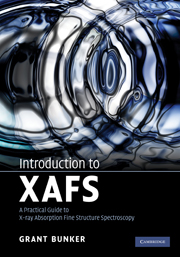Book contents
- Frontmatter
- Contents
- Preface
- 1 Introduction
- 2 Basic physics of X-ray absorption and scattering
- 3 Experimental
- 4 Theory
- 5 Data analysis
- 6 Related techniques and conclusion
- Appendix 1 Introduction to Fourier transforms in EXAFS
- Appendix 2 Cumulants in EXAFS
- Appendix 3 Optimizing X-ray filters
- Appendix 4 Reference spectra
- Appendix 5 X-ray tables
- References
- Index
4 - Theory
Published online by Cambridge University Press: 25 January 2011
- Frontmatter
- Contents
- Preface
- 1 Introduction
- 2 Basic physics of X-ray absorption and scattering
- 3 Experimental
- 4 Theory
- 5 Data analysis
- 6 Related techniques and conclusion
- Appendix 1 Introduction to Fourier transforms in EXAFS
- Appendix 2 Cumulants in EXAFS
- Appendix 3 Optimizing X-ray filters
- Appendix 4 Reference spectra
- Appendix 5 X-ray tables
- References
- Index
Summary
Introduction
XAFS theory has advanced significantly over the last several decades, driven by creative theorists, experimental demand, and Moore's law. It continues to evolve at a rapid rate. XAFS theory has benefited from and contributed to advances in many-body physics, quantum field theory, and scattering theory. Some current areas of focus include work to improve the accuracy of computing non-spherical molecular potentials, vibrational effects, and multilelectron excitations. Efforts to improve parallelization of codes to take better advantage of multiple processor cores, multiple processors, graphics processing units, computational grids, and cloud computing are also under development.
Theoretical advances have transformed the practice of data interpretation and analysis. Computer programs are now readily available for the calculation of X-ray Absorption spectra with very good accuracy in the EXAFS region, and useful accuracy in the XANES. A number of complementary theoretical approaches and the computer programs that implement them are widely disseminated and used, among them EXCURV, FEFF, GNXAS, MXAN, and FDMNES.
There is little fundamental disagreement about the correct basic physics underlying all these approaches. They differ principally in the sets of approximations that are used to make possible efficient calculation of the spectra, and in the computational algorithms that are employed. Recent progress has shown that one theoretical approach, specifically the Real Space Multiple Scattering (RSMS) formalism, is useful also for calculating X-ray emission, X-ray magnetic circular dichroism, X-ray elastic and inelastic scattering/X-ray Raman Scattering, and dielectric response functions.
- Type
- Chapter
- Information
- Introduction to XAFSA Practical Guide to X-ray Absorption Fine Structure Spectroscopy, pp. 106 - 133Publisher: Cambridge University PressPrint publication year: 2010
- 1
- Cited by

